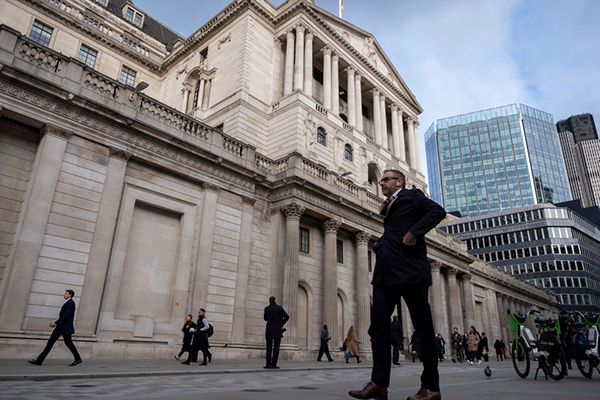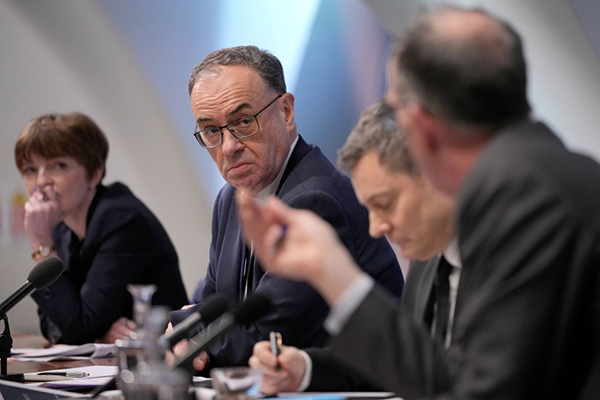UK interest rates cut to 4.5%, but should it have been more?
In a rare move, all nine policymakers voted to cut the Bank Rate, but some believe the reduction should’ve been bigger.
6th February 2025 14:10
by Craig Rickman from interactive investor

You may not be familiar with names like Sarah Breedon, Megan Greene and Alan Taylor, but their decisions throughout 2025 will influence the cost of our savings, loans and mortgages.
The trio, along with six others, make up the Bank of England’s current Monetary Policy Committee (MPC), a group tasked with setting UK interest rates.
At noon today the MPC announced it had voted by a majority of 7-2 to cut the Bank Rate 0.25 percentage points to 4.5% - its lowest level since May 2023. And interestingly, the two outliers preferred a 0.50 percentage point reduction, meaning all nine agreed that rates should come down. History tells us this is rare.
- Our Services: SIPP Account | Stocks & Shares ISA | See all Investment Accounts
A cut was what most experts and analysts had predicted. Not only is the UK witnessing sluggish economic growth that looser monetary policy should help to stimulate, but inflation defied expectations to cool in December.
The consumer prices index (CPI) headline rate eased from 2.6% to 2.5%, while year-on-year services inflation, the stubbornness of which has proved a barrier to lower interest rates, softened from 5% to 4.4%. However, the future of inflation looks less rosy, with CPI expected to speed up to 3.7% in the near term.
Given the impact that MPC decisions can have on our day-to-day finances, it’s worth taking a closer look at the body, including how it’s formed and whether members’ voting records offer any clues about future rate cuts.
MPC members’ voting records analysed
Roughly every six weeks the MPC meets for three and a half days to decides whether to cut, hold or hike interest rates. The chief reason is to make sure inflation is under control.
The committee is made up of nine members, each with a background and expertise in economics, and has independence when setting interest rates.
The MPC comprises the governor of the Bank (Andrew Bailey, who is pictured below), three deputy governors (Sarah Breedon, Clare Lombardelli, and Sir Dave Ramsden), the Bank’s chief economist (Huw Pill) and four external members (Swati Dhingra, Megan Greene, Catherine L Mann, and Alan Taylor). The appointment of external members, which are made by the chancellor and typically have a three-year term, is to provide a broader perspective, ensuring “the committee benefits from thinking and expertise in addition to that gained inside the Bank”.
Positions within the committee can change hands fairly regularly. Last year, a new deputy governor member was installed as Lombardelli replaced Ben Broadbent, while external policymaker Alan Taylor took Jonathan Haskel’s place.
The longest-standing member of the current crop is Ramsden, who has taken part in 62 interest-rate decisions, casting his maiden vote on 14 September 2017.
It stands to reason that each policymaker will have their own idea about what good monetary policy looks like, notably in which direction interest rates should head at any given time. This is reflected in members’ voting records, which reveal that some believe in a far more cautious approach to monetary policy than others.
The table below shows the numbers of times each member has opted to hike, maintain or cut interest rates during their individual tenures.

| Andrew Bailey | Sarah Breeden | Swati Dhingra | Megan Greene | Clare Lombardelli | Catherine L Mann | Huw Pill | Dave Ramsden | Alan Taylor | |
| First vote | 19-Mar-20 | 2-Nov-23 | 22-Sep-22 | 3-Aug-23 | 1-Aug-24 | 23-Sep-24 | 23-Sep-24 | 14-Sep-17 | 19-Sep-24 |
| Voted to hike | 14 | 0 | 2 | 4 | 0 | 18 | 14 | 16 | 0 |
| Voted to hold | 23 | 8 | 9 | 7 | 2 | 9 | 12 | 38 | 1 |
| Voted to cut | 4 | 3 | 9 | 2 | 3 | 1 | 2 | 8 | 3 |
| Meetings | 41 | 11 | 20 | 13 | 5 | 28 | 28 | 62 | 4 |
I should start by saying that it’s tricky to compare voting records like-for-like. However, it still shows that individuals have varying ideas about the required direction of interest rates.
Mann and Pill both held their first votes on 21 September 2023. The latter voted for a cut in November later that year, while the former preferred to hold.
The next table shows and how MPC members have voted since the rate-cutting cycle kicked off in August 2024.
| Andrew Bailey | Sarah Breeden | Swati Dhingra | Megan Greene | Clare Lombardelli | Catherine L Mann | Huw Pill | Dave Ramsden | Alan Taylor | |
| 01 August 2024 | 5.00% | 5.00% | 5.00% | 5.25% | 5.00% | 5.25% | 5.25% | 5.00% | N/A |
| 19 September 2024 | 5.00% | 5.00% | 4.75% | 5.00% | 5.00% | 5.00% | 5.00% | 5.00% | 5.00% |
| 07 November 2024 | 4.75% | 4.75% | 4.75% | 4.75% | 4.75% | 5.00% | 4.75% | 4.75% | 4.75% |
| 19 December 2024 | 4.75% | 4.75% | 4.50% | 4.75% | 4.75% | 4.75% | 4.75% | 4.50% | 4.50% |
| 06 February 2025 | 4.50% | 4.50% | 4.25% | 4.50% | 4.50% | 4.25% | 4.50% | 4.50% | 4.50% |
Mann and Pill both held their first votes on 21 September 2023. The latter voted for a cut in November later that year, while the former preferred to hold.
Interestingly, until today Mann hadn’t voted for a reduction despite taking part in 27 policy decisions, which makes the vote to slash rates by 0.50 basis points particularly eye-catching. In contrast, the member who also voted for a heftier cut, Dhingra, has preferred a reduction in nine out of 20 votes.
Looking elsewhere, Greene has preferred a hike on four occasions, and these were registered in her first four votes. The Bank Rate was indeed increased at her first meeting, held on 3 August 2023, but stayed on hold at the subsequent three.
This is contrary to Breedon, who hasn’t voted to increase rates at any of her 10 meetings, but this doesn’t raise eyebrows as inflation had cooled significantly by the time she joined the MPC.
The data here offers food for thought. The MPC’s interest rate decisions can have a sizeable impact on how we manage our finances. For example, when rates reduce, borrowing becomes more expensive, and mortgage payments are many families’ largest outgoing. The impact of today’s rate cut changes should be felt immediately if your borrowings are on a variable rate, if you have a fixed-rate expiring soon or are a first-time buyer.
- Listen to our podcast: Three big factors that influence financial markets
- Sign up to our free newsletter for investment ideas, latest news and award-winning analysis
We should note that some of the previous votes have been wafer thin, none more so than the one announced on 1 August 2024. On that occasion, the MPC voted 5-4 in favour of cutting rates, the slimmest of margins.
Can this data enable us to plot the speed of rate cuts over the coming months? Sadly not. As investors are frequently reminded, and how Mann’s vote today underscores, the past isn’t necessarily a guide to the future. Also, the majority vote of the nine-member team is what counts, so even if one or two have a particularly dovish or hawkish approach to monetary policy in any given decision, to influence rates at least four others must agree with them.
That said, individual voting records may offer some indication about which way certain MPC members may err towards if the call is on a knife edge. And there could be several of those this year, as policymakers walk the tightrope between controlling inflation and kickstarting economic growth.
What will the MPC do with interest rates in 2025?
Predictions about the volume of cuts this year are mixed. Some expect two more reductions, meaning interest rates would finish 2025 at 4%. Others, such as US investment banking giant Morgan Stanley, feel this estimate is conservative, forecasting five cuts this year, slashing the Bank Rate to 3.5% to give the UK economy a shot in the arm.
Ultimately, the economic picture will determine what comes to pass. The Bank has always stressed that it will base rate decisions on the latest data and forecasts. What perhaps is telling is that the Bank has alternated between reductions and holds since kicking off the rate-cutting cycle in August 2023.
What are the headwinds for future rate cuts?
As noted above, policymakers will be keeping a close watch on inflation.
While December’s data was encouraging, however, several headwinds have emerged. These include Trump’s trade tariffs, higher energy prices, and the impending hikes to employer national insurance (NI) and the national living wage. Several retailers have already announced plans to increase prices to offset higher taxes.
- 16 UK stocks least likely to be impacted by Trump tariffs
- Stockwatch: has the stock market correctly priced in Trump tariffs?
Another factor is average weekly earnings, which increased at an annual rate of 5.6% in November, putting more money in workers’ pockets.
The combination of these explain why the Bank expects inflation to tick up to 3.7% in the coming months, almost double its 2% target.
After announcing today’s cut, the MPC said that recent developments would not lead to additional second-round effects on underlying domestic inflationary pressures.
“Compared with economic conditions during the succession of large external cost shocks in 2021-22, the labour market was now looser and therefore some of the dynamics observed previously were unlikely to reoccur.”
These articles are provided for information purposes only. Occasionally, an opinion about whether to buy or sell a specific investment may be provided by third parties. The content is not intended to be a personal recommendation to buy or sell any financial instrument or product, or to adopt any investment strategy as it is not provided based on an assessment of your investing knowledge and experience, your financial situation or your investment objectives. The value of your investments, and the income derived from them, may go down as well as up. You may not get back all the money that you invest. The investments referred to in this article may not be suitable for all investors, and if in doubt, an investor should seek advice from a qualified investment adviser.
Full performance can be found on the company or index summary page on the interactive investor website. Simply click on the company's or index name highlighted in the article.